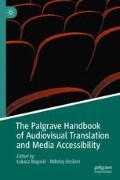Abstract
Video games are nowadays conceived as global products; localised versions are produced in parallel with the original one, which enables shared authorship and the possibilities of co-creation. The industrial workflow requires the collaboration between all teams to guarantee the playability of each of the language versions. Each localisation is its own original. Accessibility has also become a concern so localisers work both interlingually and intralingually to enhance user experience and guarantee playability for all demographics targeted. The localisation process replaces text, graphic, musical and gameplay assets but only linguistic testers can ascertain that it all functions as expected during play testing, so each version has to be controlled separately but concurrently in order to guarantee the success of the global sim-ship. Glocalisation is the business strategy for game design and development that companies favour because it allows them to control their IP better as well as fight piracy and maintain global quality.
Access this chapter
Tax calculation will be finalised at checkout
Purchases are for personal use only
References
Abad, B., & Valdés, C. (Eds.). (2004). The Translator 10.
Barnes, W., Walker, J., Rubio, I., & Flew, A. (2013, January). Implementing Blizzard’s Localization Vision in Real Time. Game Developers Conference Vault. Retrieved from https://www.gdcvault.com/play/1018128/Implementing-Blizzard-s-Localization-Vision.
Bernal-Merino, M. Á. (2016b). Creating Felicitous Gaming Experiences: Semiotics and Pragmatics as Tools for Video Game Localisation. Signata, 7(1), 231–253. Liège: Université de Liège.
Bernal-Merino, M. Á. (2018a). Creativity and Playability in the Localisation of Video Games. The Journal of Internationalization and Localization, 5(1), 75–96. Amsterdam: John Benjamins Publishing Company.
Bernal-Merino, M. Á. (2018b). Quantum Identity and the Enhancement of Communication. Journal of Brand Strategy, 6(4), 380–391. London and Birmingham: Henry Stewart Publications.
Bernal-Merino, M. Á. (2015). Translation and Localisation in Video Games. Making Entertainment Software Global. New York and Oxon: Routledge.
Bernal-Merino, M. Á. (2016a). The Glocalization and Co-Creation in Video Games. In D. Thussu (Ed.), Media Across Borders: Localizing TV, Film and Video Games (pp. 202–219). London and New York: Routledge.
Crosignani, S., & Ravetto, F. (2011). Localizing the Buzz! Game Series, or How to Successfully Implement Transcreation in a Multi-million Seller Video Game. TRANS. Revista de Traductología, 15, 29–38.
Desblache, L. (2019). Music and Translation. New Mediations in the Digital Age. London: Palgrave Macmillan.
Díaz-Cintas, J., & Remael, A. (2014). Audiovisual Translation, Subtitling. Oxon and New York: Routledge.
Electronic Arts. Accessibility page. www.ea.com/able.
Ellefsen, U., & Bernal-Merino, M. Á. (2018). Harnessing the Roar of the Crowd: A Quantitative Study of Language Preferences in Video Games of French Players of the Northern Hemisphere. The Journal of Internationalization and Localization, 5(1), 21–49. Amsterdam: John Benjamins Publishing Company.
Fryer, L. (2016). An Introduction to Audio Description: A Practical Guide. London: Routledge.
Game Accessibility Guidelines. http://gameaccessibilityguidelines.com/basic/
Giné, J. (2009, 23 March). Localization: The Pathway to Truly Global Game Development. Keynote Presented at the Localization Summit, Game Developers Conference. San Francisco.
Grice, P. (1975). Logic and Conversation. In P. Cole & J. Morgan (Eds.), Syntax and Semantics. 3: Speech Acts (pp. 41–58). New York: Academic Press.
Ipsos Connect. (2017). The New Faces of Gaming. Online. Retrieved from www.isfe.eu/sites/isfe.eu/files/attachments/ipsos_connect_gaming_feb_17.pdf
Lathey, G. (Ed.). (2006). The Translation of Children’s Literature: A Reader. Clevedon, UK: Multilingual Matters Ltd.
Leka, B., Mangell, P., & Reynolds, P. (2014). Getting the Translation Guild’s Name on the Trophy. Game Localization Round Table.
Mangiron, C., Orero, P., & O’Hagan, M. (Eds.). (2014). Fun for All: Translation and Accessibility Practices in Video Games and Virtual Worlds. Bern: Peter Lang.
Maxwell-Chandler, H., & O’Malley-Deming, S. (2012). The Game Localization Handbook (2nd ed.). Sudbury, MA: Jones and Bartlett Learning.
McKearney, J. (2007, 16 October). A New Marketing Tool: Enhanced Localization. Presented at the Game Localization Round Table. Localization World International Conference. Seattle.
Milder, L. (2009). Wolfenstein. Retrieved from https://www.schnittberichte.com/schnittbericht.php?ID=5982811.
Morris, D. (2013). A New (and Way Better) Model for Licensed Games. Game Developers Conference. Retrieved from www.gdcvault.com/play/1018054/A-New-(and-Way-Better)
Newzoo. (2019). Global Game Market Report 2018. Retrieved from https://newzoo.com/.
O’Dwyer, D. (2017). Translating and Adapting The Witcher. Noclip, Patreon.com. Online. Retrieved from www.youtube.com/watch?v=Gxg5INjNopo.
O’Hagan, M., & Mangiron, C. (2013). Game Localization: Translating for the Global Digital Entertainment Industry. Amsterdam: John Benjamins.
PEGI. (2019). Statistics about PEGI. Online. Retrieved from https://pegi.info/page/statistics-about-pegi.
Samora, F., & Airey, E. (2011). Game Testing and Localisation. Presentation delivered at University of Roehampton.
Santoyo, J. C. (1989). Traducciones y adaptaciones teatrales: ensayo de una tipología. Cuadernos de teatro clásico, 4, 96–107.
Williams, D. (2013). De-signing the Design: The Semiotics of Choice. Gamasutra. Retrieved from www.gamasutra.com/blogs/DaveWilliams/20131030/202147/Designing_the_Design_the_Semiotics_of_Choice.php.
Gameography
Assassin’s Creed: Unity (Ubisoft 2014).
Batman Arkham City (Warner Bros. Interactive Entertainment 2011).
Buzz! (Relentless Software 2005–2010).
Mass Effect series (Bioware, Electronic Arts 2008–present).
The Witcher 3: Wild Hunt (CD Project red 2015–present).
Wolfenstein series (Bethesda soft 1981–present).
Author information
Authors and Affiliations
Corresponding author
Editor information
Editors and Affiliations
Rights and permissions
Copyright information
© 2020 The Author(s)
About this chapter
Cite this chapter
Bernal-Merino, M.A. (2020). Key Concepts in Game Localisation Quality. In: Bogucki, Ł., Deckert, M. (eds) The Palgrave Handbook of Audiovisual Translation and Media Accessibility. Palgrave Studies in Translating and Interpreting. Palgrave Macmillan, Cham. https://doi.org/10.1007/978-3-030-42105-2_15
Download citation
DOI: https://doi.org/10.1007/978-3-030-42105-2_15
Published:
Publisher Name: Palgrave Macmillan, Cham
Print ISBN: 978-3-030-42104-5
Online ISBN: 978-3-030-42105-2
eBook Packages: Social SciencesSocial Sciences (R0)

